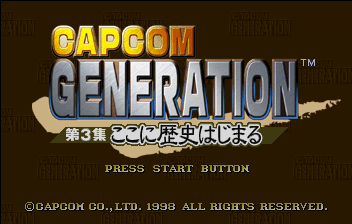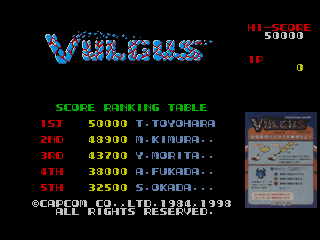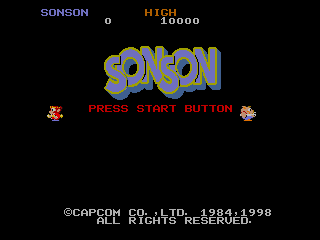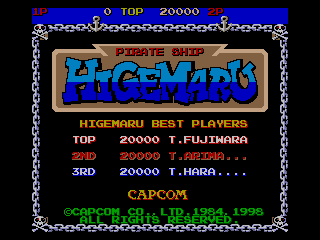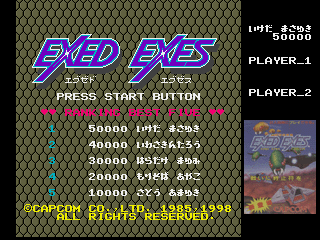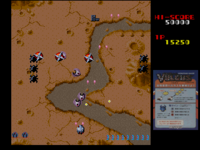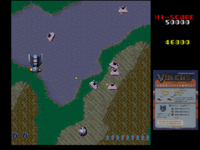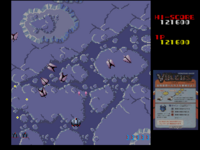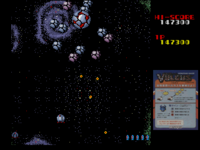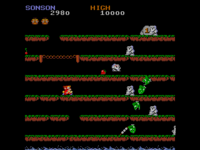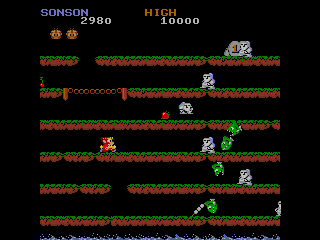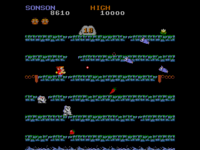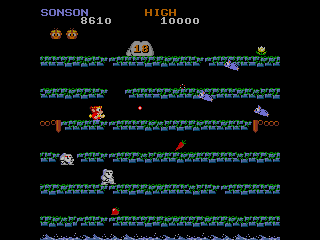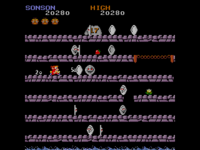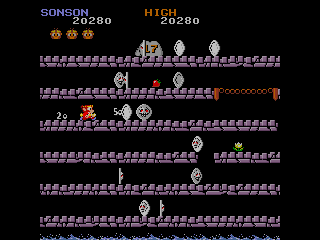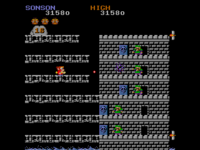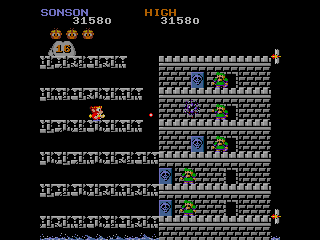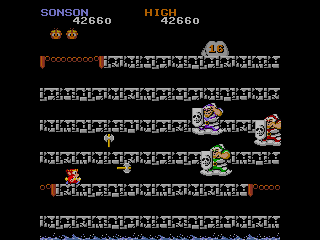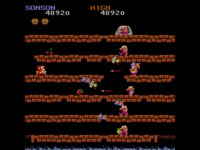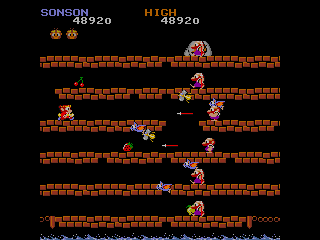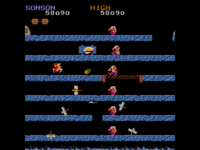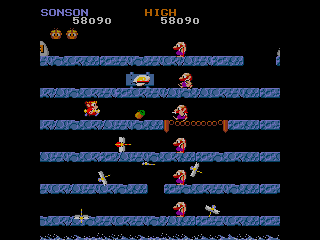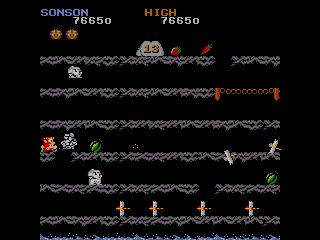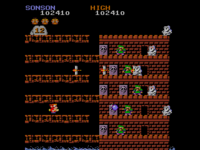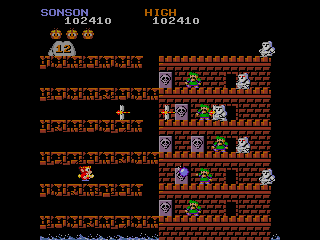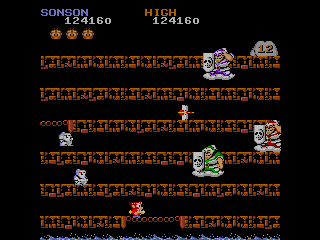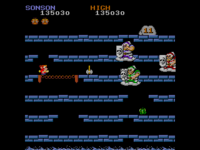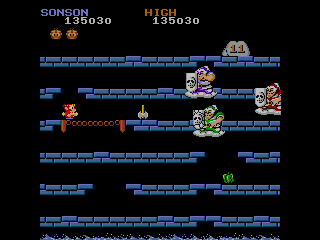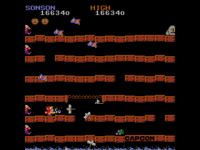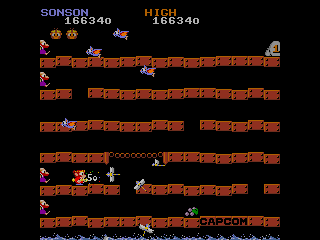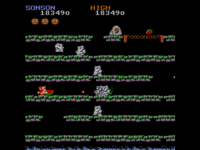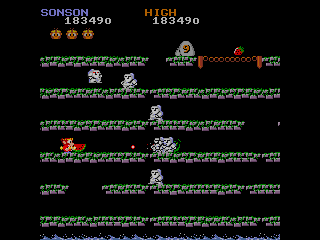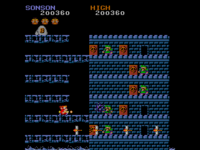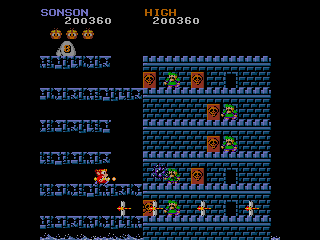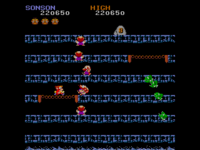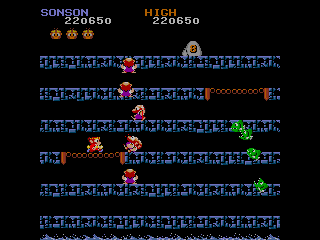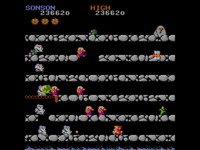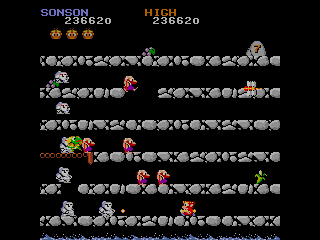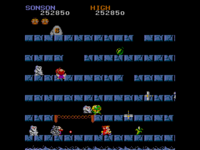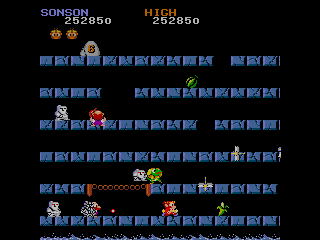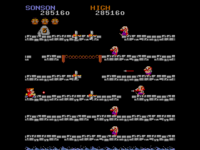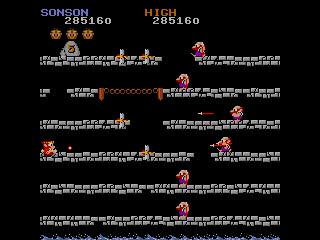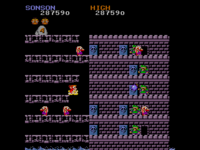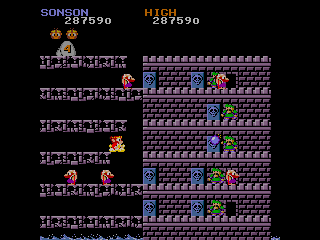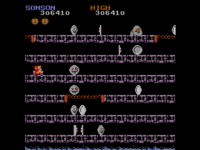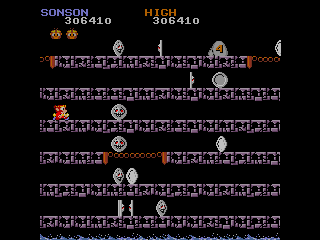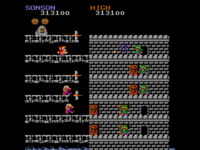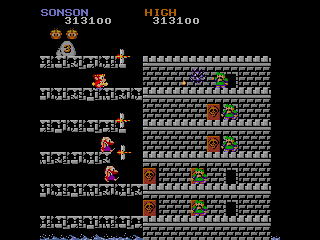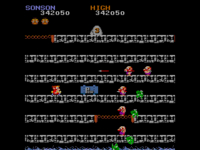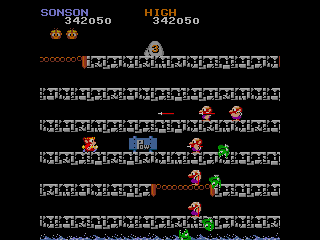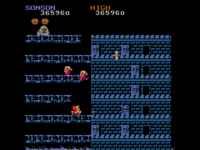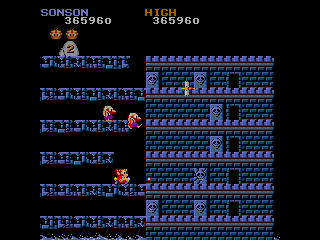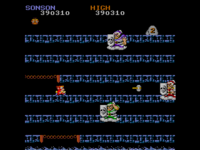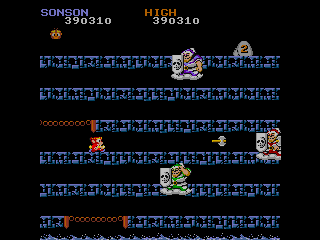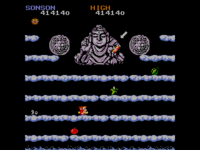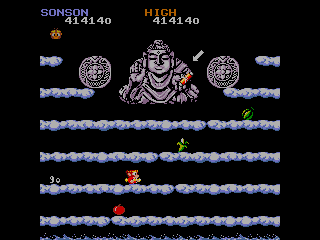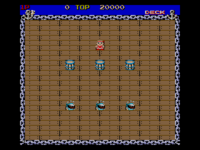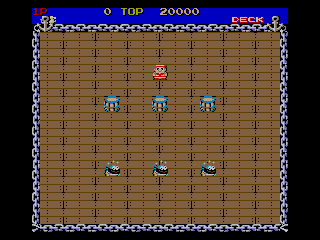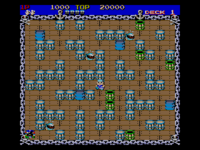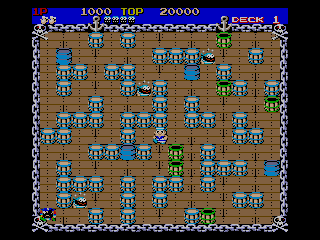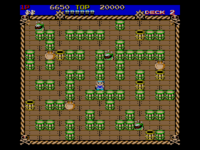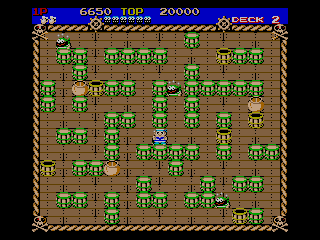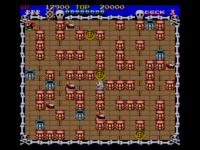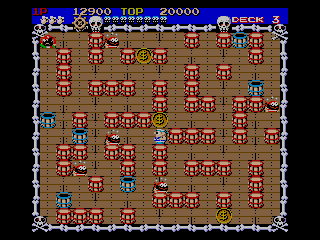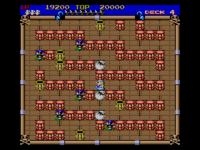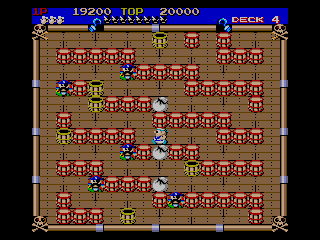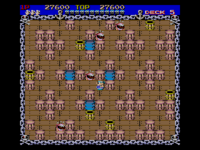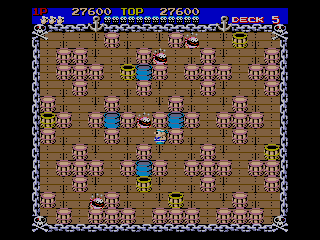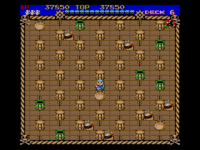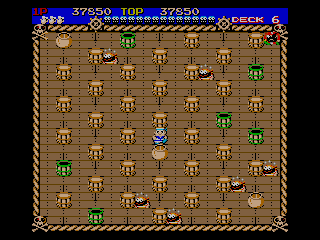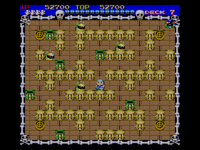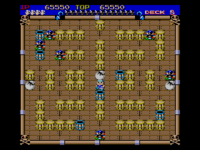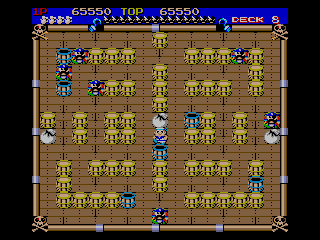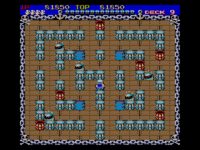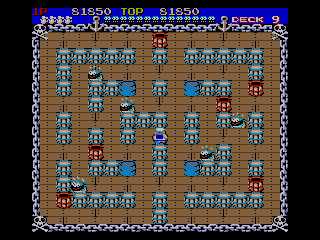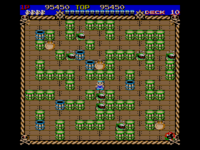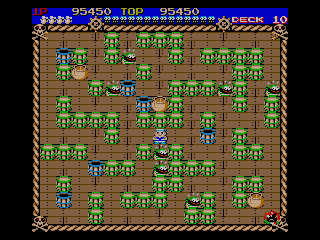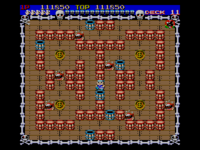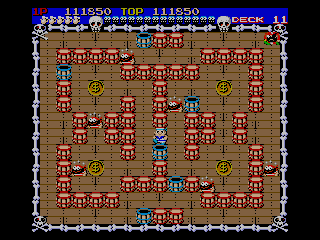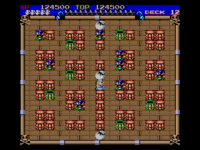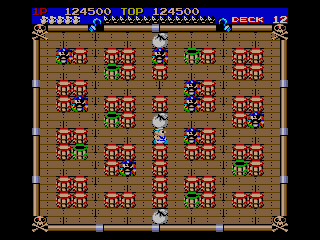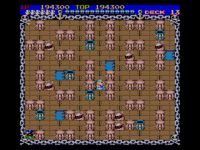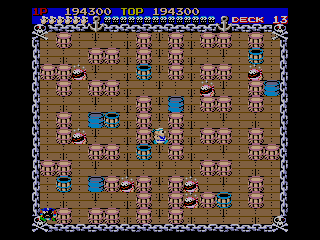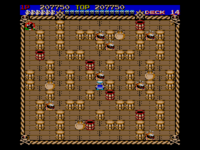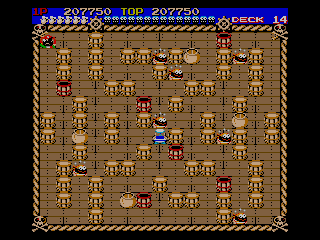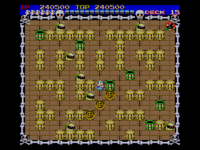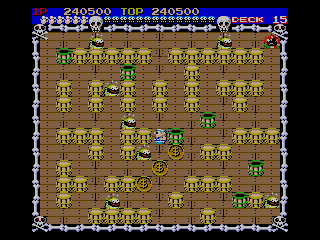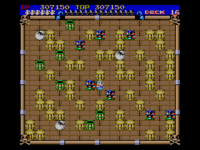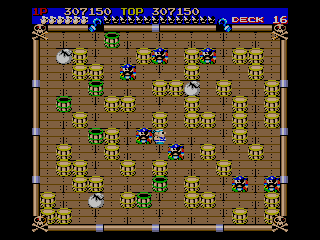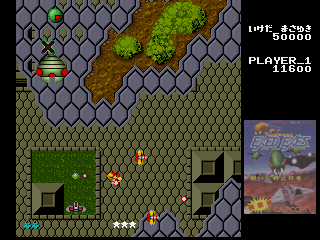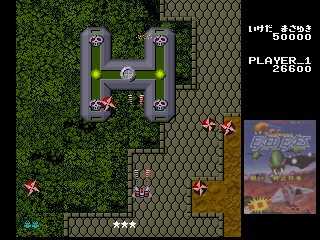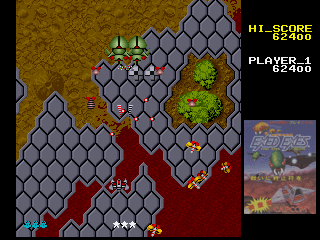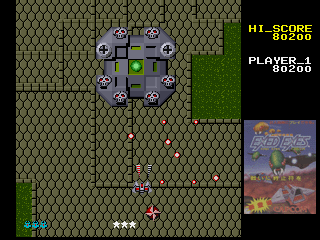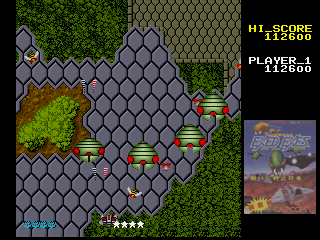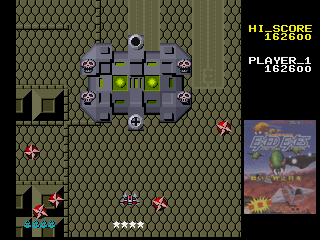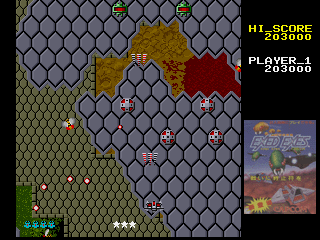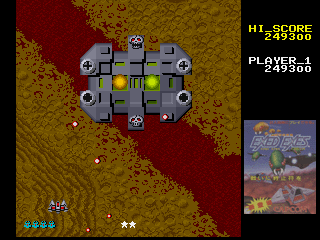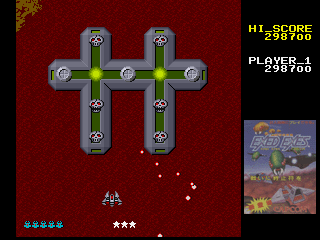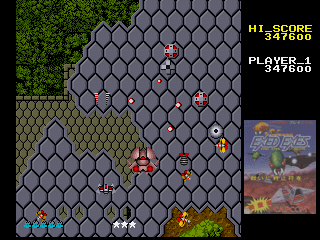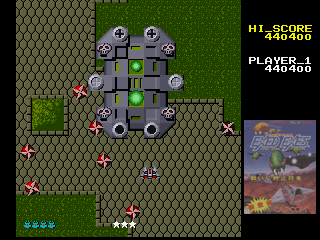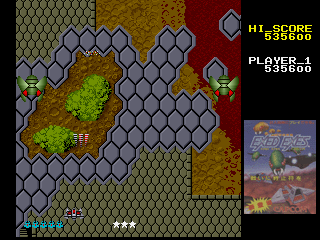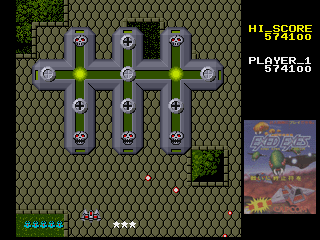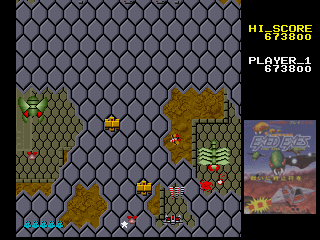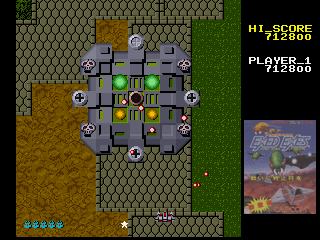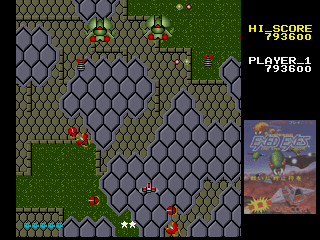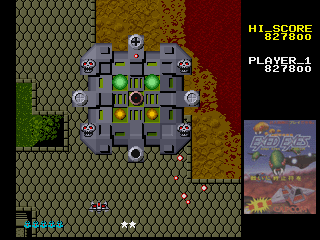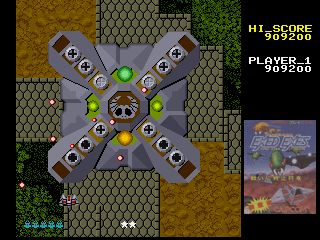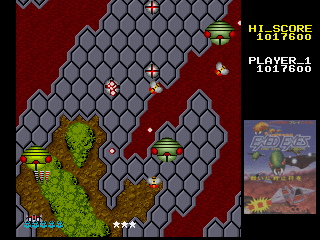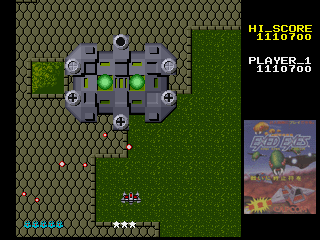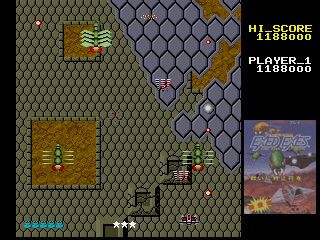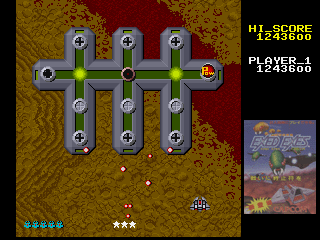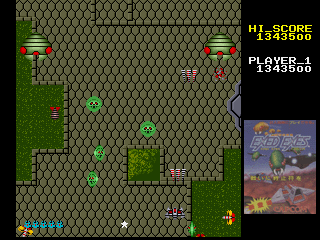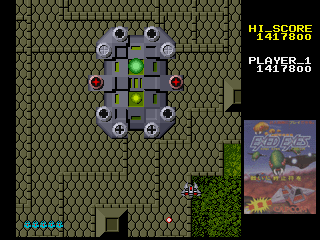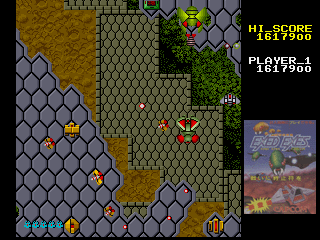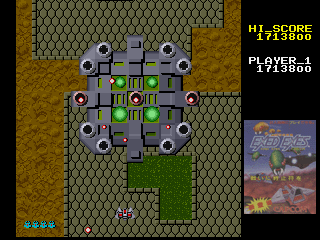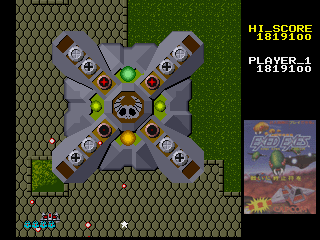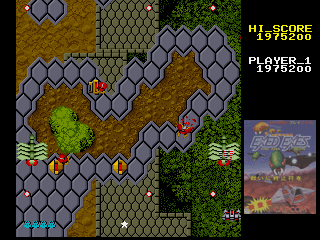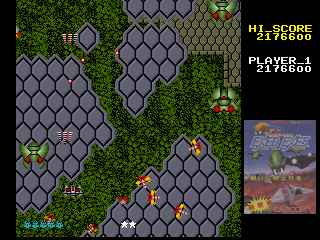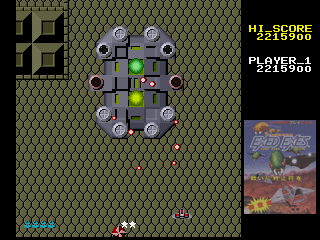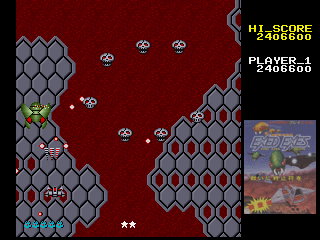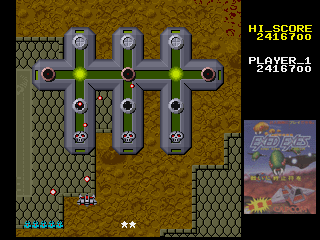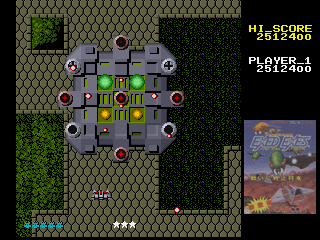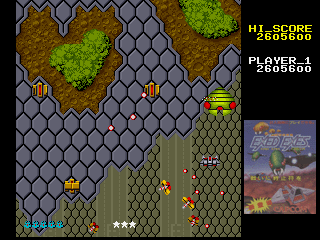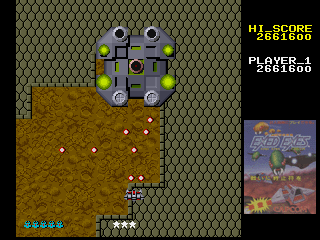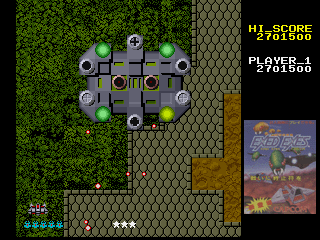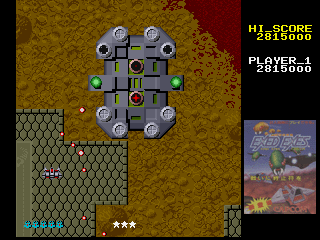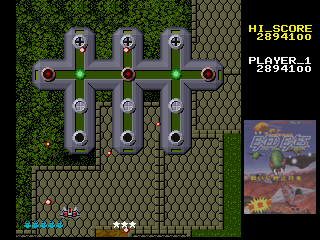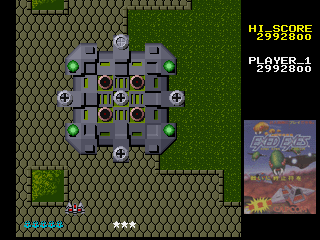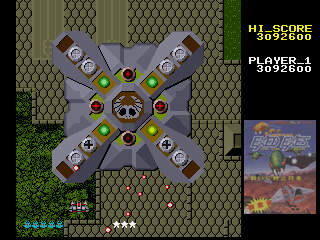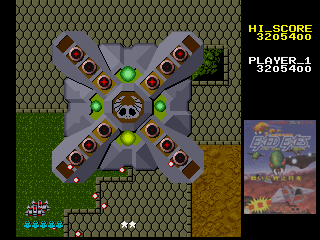Capcom Generation: Dai 3 Shuu Koko ni Rekishi Hajimaru
From Sega Retro
| ||||||||||
| Capcom Generation: Dai 3 Shuu Koko ni Rekishi Hajimaru | ||||||||||
|---|---|---|---|---|---|---|---|---|---|---|
| System(s): Sega Saturn | ||||||||||
| Publisher: Capcom | ||||||||||
| Developer: Capcom | ||||||||||
| Original system(s): all four games ran on their own unique arcade boards | ||||||||||
| Game total: 4 | ||||||||||
| Sound driver: SCSP/CD-DA (65 tracks) | ||||||||||
| Peripherals supported: 6Player | ||||||||||
| Genre: Compilation, Variety (バラエティ)[1], Table[2] | ||||||||||
| Number of players: 1-2 | ||||||||||
| ||||||||||
|
Capcom Generation: Dai 3 Shuu Koko ni Rekishi Hajimaru (カプコンジェネレーション第3集 ここに歴史はじまる, "History Begins Here") is the third of five compilations for the Sega Saturn (and PlayStation) developed by Capcom.
The third volume features four of the first five video games developed by Capcom (the missing game, 1942, was previously included in Capcom Generation: Dai 1 Shuu Gekitsuiou no Jidai).
Contents
Games included
- Vulgus
- SonSon
- Pirate Ship Higemaru
- Exed Exes
Every game has a "Collection" with artwork (including promotional art and concept art), information, and game tips. Options and high scores can be saved to the Saturn's internal memory.
Gameplay
Vulgus
Vulgus is the first video game created by Capcom, originally released in 1984. It is a vertically scrolling shoot-'em-up, similar to rival Namco's 1982 hit Xevious. The player controls a spaceship and must destroy endless waves of incoming enemies. There is an alternating two-player mode. The game does not have distinct levels; the background alternates between the surface of a planet and a space field. The Vulgus, a molten rock, is the boss of the game. Once it is destroyed, the game loops from the beginning of the level with increased difficulty until the player loses or decides to stop playing. The Yashichi (ヤシチ), a pinwheel-like object that would make numerous appearances in subsequent Capcom games (usually as a power-up), debuts here as an enemy.
The spaceship moves in any direction using the D-Pad. Its primary weapon, two parallel shots, can be fired with ![]() or
or ![]() . There are two rapid-fire buttons that shoot faster,
. There are two rapid-fire buttons that shoot faster, ![]() (low speed) or
(low speed) or ![]() (high speed). It has a secondary supply of missiles that can be fired straight ahead with
(high speed). It has a secondary supply of missiles that can be fired straight ahead with ![]() . The missiles can penetrate through multiple targets in a line or instantly eradicate a single large enemy that normally takes multiple shots to destroy. The primary weapon is unlimited; the missiles are limited, but the player can acquire more by picking up "POW" items. Bonus points are awarded for destroying every enemy in a formation or for destroying multiple enemies with a single missile.
. The missiles can penetrate through multiple targets in a line or instantly eradicate a single large enemy that normally takes multiple shots to destroy. The primary weapon is unlimited; the missiles are limited, but the player can acquire more by picking up "POW" items. Bonus points are awarded for destroying every enemy in a formation or for destroying multiple enemies with a single missile.
The spaceship is destroyed in a single hit from an enemy, but it respawns at a predetermined checkpoint if the player has extra lives left. The game ends if the player runs out of lives. Extends are given at 20,000 points, then every 40,000 points after that.
The player can change the number of starting lives (1, 2, 3, or 5). Since the original game uses a vertical aspect ratio, there are three screen modes: Type 1 interpolates the image to fit into the height of the Saturn's video mode, Type 2 (the default) crops the playfield to fit the screen, and Type 3 preserves the vertical aspect ratio (but requires the player to rotate the monitor).
Items
| POW | |
|---|---|
| Restocks the spaceship with another missile (up to a maximum of 15). | |
| 敵サインS | |
| Prevents the movement speed of enemies from increasing. | |
| 敵サインE | |
| Prevents the attack speed of enemies from increasing. | |
| 敵サインD | |
| Prevents the number of enemies from increasing. | |
| Sakichi (佐吉) | |
| Awards 10,000 bonus points. This item only appears if the player has previously collected the S, E, and D items. |
SonSon
SonSon is Capcom's second video game, originally released in 1984. It is a platforming game that plays similarly to a shoot-'em-up since the screen continually scrolls through the stage, enemies enter the screen in formations, and the characters have a high degree of vertical movement because every stage consists of multiple stacked platforms. It supports two players playing simultaneously, with player one playing as SonSon (ソンソン), a monkey boy patterned after Sun Wukong in the 16th century Chinese novel Journey to the West, and player two controlling the pig TonTon (トントン), who is based on Zhu Wuneng from the same story. The pair are on a mission across China to receive a scroll from Buddha and must battle bats, rats, mad bombers, and other enemies. The game is divided into 19 stages, played continuously as a single long stage. On some stages, the screen stops scrolling to fight a fortress of enemies. After completing the game, it loops again from the beginning at a higher difficulty.
Every stage consists of six platforms, which occasionally have small gaps that the characters can fall through. SonSon and TonTon automatically walk forwards, but they can turn around by pressing ![]() or
or ![]() or run faster by holding
or run faster by holding ![]() or
or ![]() . They can collect foods along the way for bonus points, and there is an item that can turn enemies into foods that can also be collected for points. They can jump between platforms by pressing
. They can collect foods along the way for bonus points, and there is an item that can turn enemies into foods that can also be collected for points. They can jump between platforms by pressing ![]() or
or ![]() . Switching platforms can be done to collect items or to reach or avoid enemies, and enemies can change platforms as well. The characters attack by shooting energy pellets partway across the screen, which can be done by pressing
. Switching platforms can be done to collect items or to reach or avoid enemies, and enemies can change platforms as well. The characters attack by shooting energy pellets partway across the screen, which can be done by pressing ![]() ,
, ![]() ,
, ![]() ,
, ![]() ,
, ![]() , or
, or ![]() . They shoot in whichever direction they are facing and can intercept enemy projectiles with their attacks.
. They shoot in whichever direction they are facing and can intercept enemy projectiles with their attacks.
Touching an enemy or an unfriendly projectile causes SonSon or TonTon to lose a life. If a player has any additional lives, they are returned to the screen riding on a cloud that gives them temporary invincibility. They can shoot while riding a cloud. The cloud disappears and the character starts walking instead after a short time or if the player presses the D-Pad in any direction. The game ends if the player runs out of lives. Extra lives are given at 20,000 and 80,000 points, then every 100,000 points after that.
There are four difficulty levels (Easy, Normal, Hard, and Expert), and the player can change the number of starting lives (3, 4, 5, or 7).
Items
| POW | |
|---|---|
| This item appears after collecting 8 large food items. It transforms any on-screen enemies into large food items. | |
| Bamboo Shoot | |
| This item appears after walking over certain secret spots. It awards 500 points for making it appear and another 1,000 points for collecting it. | |
| Yashichi (ヤシチ) | |
| This item appears after destroying all of the flashing barriers on a fortress within 20 seconds. It awards 4,000 points. | |
| Frilled Lizard | |
| This creature appears after missing a large food item worth between 1,000 and 9,000 points (all of them except the strawberry). It awards half the number of points of the missed item if caught. | |
| Lark | |
| This creature appears after missing a large food item worth 10,000 points (the strawberry). It drops a cake (which is worth 5,000 points). | |
| Scroll | |
| This item appears in the hand of the Buddha statue at the end of the game. It awards 30,000 points and ends the game when collected. |
Small fruits
| Tulips | |
|---|---|
| Worth 10 points. | |
| Radish | |
| Worth 10 points. | |
| Dumplings | |
| Worth 20 points. | |
| Cherries | |
| Worth 20 points. | |
| Carrot | |
| Worth 30 points. | |
| Oyster | |
| Worth 30 points. | |
| Strawberry | |
| Worth 40 points. | |
| Mushroom | |
| Worth 40 points. | |
| Tomato | |
| Worth 50 points. | |
| Orange | |
| Worth 50 points. | |
| Snow Peas | |
| Worth 60 points. | |
| Lemon | |
| Worth 60 points. | |
| Small Watermelon | |
| Worth 70 points. | |
| Grapes | |
| Worth 70 points. | |
| Bell Pepper | |
| Worth 80 points. | |
| White Radish | |
| Worth 80 points. | |
| Muscat Grapes | |
| Worth 90 points. | |
| Apple | |
| Worth 90 points. | |
| Banana | |
| Worth 100 points. | |
| Large Watermelon | |
| Worth 100 points. |
Large fruits
Collecting 6 small food items causes a large food item to appear in front of a wooden sign.
| Carrot | |
|---|---|
| Worth 1,000 points. | |
| Fries | |
| Worth 2,000 points. | |
| Fried Egg | |
| Worth 3,000 points. | |
| Persimmon | |
| Worth 4,000 points. | |
| Cake | |
| Worth 5,000 points. | |
| Frankfurter | |
| Worth 6,000 points. | |
| Fried Shrimp | |
| Worth 7,000 points. | |
| Watermelon | |
| Worth 8,000 points. | |
| Pineapple | |
| Worth 9,000 points. | |
| Giant Strawberry | |
| Worth 10,000 points. |
Stages
The stage numbers count down from 19 to 1.
Pirate Ship Higemaru
Pirate Ship Higemaru is Capcom's third video game, originally released in 1984. It is a puzzle game with an overhead perspective and plays similarly to Sega's 1982 arcade game Pengo. The player controls a sailor named Momotaru (モモタルー), who must defeat the dreaded pirate crew known as the Higemaru Corps (ひげ丸軍団), led by their captain, Bows (ボウス), by throwing barrels and other objects at them. The game is divided into 16 levels, called "decks." Every deck has a set number of pirates to be eliminated, as well as Bows, a special pirate who respawns each time he is defeated. Bows does not have to be eliminated in order to complete the deck. Every fourth deck is a "Hi-Point Deck" against a group of enemies entirely made up of Bows where the barrels are worth an increased number of points.
Momotaru moves in any direction using the D-Pad. He has no attacks of his own, but he can grab barrels, drums, giant coins, and other objects and throw them in any of the four cardinal directions. He grabs an object by pressing ![]() ,
, ![]() ,
, ![]() ,
, ![]() ,
, ![]() , or
, or ![]() when standing adjacent to it, then throws it by pressing a button again. He can walk while carrying an object. Any pirate who stands in the way of an object that has been thrown (even if standing in an adjacent line) is hurled off the screen. Barrels that hit the walls of the level or other barrels or objects shatter and award bonus points, while other objects are invulnerable and do not award points. Eliminating multiple enemies with the same barrel awards extra points. Because barrels also act as barriers, picking up and destroying barrels opens up new paths for Momotaru but also enemies. Some pirates try to hide in barrels; these enemies have to be hit once to knock them out of the barrel (in a stunned state), then hit again to eliminate them. These barrels have faces on them and cannot be picked up.
when standing adjacent to it, then throws it by pressing a button again. He can walk while carrying an object. Any pirate who stands in the way of an object that has been thrown (even if standing in an adjacent line) is hurled off the screen. Barrels that hit the walls of the level or other barrels or objects shatter and award bonus points, while other objects are invulnerable and do not award points. Eliminating multiple enemies with the same barrel awards extra points. Because barrels also act as barriers, picking up and destroying barrels opens up new paths for Momotaru but also enemies. Some pirates try to hide in barrels; these enemies have to be hit once to knock them out of the barrel (in a stunned state), then hit again to eliminate them. These barrels have faces on them and cannot be picked up.
Momotaru's enemies do not have attacks, but a single touch from an enemy causes him to die and be revived at the cost of one extra life. The game ends when the player runs out of lives. Extra lives are given at 10,000 and 50,000 points, then every 50,000 points after that. When a player has scored more than a million points, the game stops awarding the player with bonus lives. When the player has taken 70 seconds on the same deck, the music changes and the skull-and-crossbones symbols in the four corners of the screen start to move around the edges of the screen. Touching a skull-and-crossbones costs Momotaru a life.
The player can change the number of starting lives (1, 2, 3, or 5).
Items
| Invincibility | |
|---|---|
| Makes Momotaru temporarily invincible so he can defeat enemies by walking into them and stuns all enemies except Bows. These items appear for every 16 barrels destroyed. All of them have the same effect despite looking different. Worth 500 points. |
Bonus
These items are found in glowing barrels and award bonus points.
| Tai Fish | |
|---|---|
| Worth 400 points. | |
| Puffer Fish | |
| Worth 800 points. | |
| Starfish | |
| Worth 1,000 points. | |
| Pipe | |
| Worth 1,000 points. | |
| Scallop | |
| Worth 1,500 points. | |
| Squid | |
| Worth 2,000 points. | |
| Octopus | |
| Worth 2,500 points. | |
| Sword | |
| Worth 2,500 points. | |
| Spyglass | |
| Worth 3,000 points. |
Hidden
These special items are only found by lifting certain barrels first on a deck.
| Strawberry | |
|---|---|
| Worth 10,000 points. | |
| Yashichi (ヤシチ) | |
| Worth 20,000 points. | |
| Golden Bird | |
| Worth 50,000 points. | |
| Whale | |
| Worth 50,000 points. | |
| Sailor's Outfit | |
| Gives the player an extra life. |
Decks
There are 16 decks. At the beginning of each deck, the pirates pop out of barrels in a temporary stunned state (and Momotaru can safely walk through them). With each successive deck, the speed and intelligence of the pirates increase; after deck 10, the pirates can move faster than Momotaru. After completing deck 16, the game repeats decks 9 to 16, so it never ends until the player loses or decides to stop playing.
Exed Exes
Exed Exes is Capcom's fifth video game (following 1942), originally released in 1985. It is a vertically scrolling shoot-'em-up and considered a spiritual successor to Vulgus. The player must pilot a spaceship through an alien hive populated by insect-like aliens called Exes who are trying to invade Earth. There is two-player simultaneous play. The game is broken into 16 rounds, each ending with one or more boss fights. There are a mix of ground and air enemies, and enemies can enter from any side of the screen. Some rounds contain a "Hi-Point Area" midway through where the background darkens and the player can collect an item that turns all of the enemies into fruits that can be collected for bonus points. Bosses contain guns, skulls, and glowing radars that must be destroyed. If the guns and skulls are destroyed before the radars, the boss starts to escape. The player is given a bonus if the boss is completely destroyed without escaping.
The ship moves in any direction using the D-Pad. It fires its main weapon, two parallel shots with partial range, with ![]() or
or ![]() . There are power-ups that upgrade the strength and range of the main weapon. There are two rapid-fire buttons that shoot faster,
. There are power-ups that upgrade the strength and range of the main weapon. There are two rapid-fire buttons that shoot faster, ![]() (low speed) or
(low speed) or ![]() (high speed). It is equipped with a limited supply of "Mega Crash" bombs that can be used with
(high speed). It is equipped with a limited supply of "Mega Crash" bombs that can be used with ![]() . These bombs dissipate any enemy projectiles on the screen but do not damage enemies.
. These bombs dissipate any enemy projectiles on the screen but do not damage enemies.
The ship is destroyed in a single hit from an enemy, but it respawns in place if the player has extra lives left. The game ends if the player runs out of lives. Extends are given every 50,000 points until 250,000 points, then every 250,000 points after that. The game loops over again at a higher difficulty after the final round is completed and continues looping until the player reaches 10,000,000 points.
The player can change the number of starting lives (1, 2, 3, or 5). Since the original game uses a vertical aspect ratio, there are three screen modes: Type 1 interpolates the image to fit into the height of the Saturn's video mode, Type 2 (the default) crops the playfield to fit the screen, and Type 3 preserves the vertical aspect ratio (but requires the player to rotate the monitor).
Items
| POW黄 | |
|---|---|
| Changes the ship's weapon to double beams with increased range. | |
| POW白 | |
| Changes the ship's weapon to triple beams with increased range. | |
| POW緑 | |
| Changes the ship's weapon to triple beams with full-screen range. | |
| WOP | |
| Resets the ship's weapon to its default shot. Worth 10,000 points. | |
| Sakichi (佐吉) | |
| Equips the ship with another Mega Crash bomb (up to a maximum of 10). This item appears every 50,000 points until 250,000 points, then every 250,000 points after that. Worth 5,000 points. | |
| POW | |
| Transforms all on-screen enemies into fruit (reminiscent of SonSon). | |
| Holstein (ホルスタイン) | |
| Worth 50,000 points. |
Fruits
| Carrot | |
|---|---|
| Worth 500 points. | |
| Apple | |
| Worth 500 points. | |
| Banana | |
| Worth 1,000 points. | |
| Grapes | |
| Worth 1,000 points. | |
| Strawberry | |
| Worth 2,000 points. | |
| Pear | |
| Worth 2,000 points. | |
| Tomato | |
| Worth 3,000 points. | |
| Lime | |
| Worth 5,000 points. | |
| Lemon | |
| Worth 5,000 points. | |
| Orange | |
| Worth 5,000 points. | |
| Pineapple | |
| Worth 20,000 points. | |
| Giant Strawberry | |
| Worth 10,000 points. |
Rounds
| Round 1 | |
|---|---|
|
Boss: クルス | |
| Round 2 | |
|
Boss: EXES1号 | |
| Round 3 | |
|
Boss: EXES3号 | |
| Round 4 | |
|
Bosses: EXES3号, ツインクル | |
| Round 5 | |
|
Boss: EXES2号 | |
| Round 6 | |
|
Boss: トリクル | |
| Round 7 | |
|
Boss: Super Exes | |
| Round 8 | |
|
Bosses: Super Exes, 試作型 Exed Exes | |
| Round 9 | |
|
Bosses: クルス, EXES3号 | |
| Round 10 | |
|
Bosses: EXES1号, トリクル | |
| Round 11 | |
|
Bosses: EXES2号, Super Exes | |
| Round 12 | |
|
Bosses: ツインクル, Super Exes, 試作型 Exed Exes | |
| Round 13 | |
|
Bosses: Super Exes, 試作型 Exed Exes | |
| Round 14 | |
|
Bosses: EXES2号, 試作型 Exed Exes | |
| Round 15 | |
|
Bosses: トリクル, Super Exes | |
| Round 16 | |
|
Bosses: クルス, EXES1号, EXES3号, ツインクル, EXES2号, トリクル, Super Exes, 試作型 Exed Exes, Exed Exes | |
| The player fights every previously encountered boss at the end of this round, plus the final boss, the Exed Exes. |
History
Release
This is the third release in the Capcom Generation series. The Sega Saturn versions of these games were exclusively released in Japan, but the PlayStation versions of the first four volumes were also released in Europe as part of a bundle titled Capcom Generations (except for the German version, which omits the fourth volume).
Magazine articles
Promotional material
Physical scans
| Sega Retro Average | ||||||||||||||||||||||||
|---|---|---|---|---|---|---|---|---|---|---|---|---|---|---|---|---|---|---|---|---|---|---|---|---|
|
| 62 | |
|---|---|
| Based on 4 reviews | |
Technical information
References
- ↑ File:CapcomGeneration3 Saturn JP Box Back.jpg
- ↑ 2.0 2.1 https://sega.jp/history/hard/segasaturn/software_l.html#tab04 (Wayback Machine: 2019-12-07 02:59)
- ↑ Sega Saturn Magazine, "1998-30 (1998-10-23)" (JP; 1998-10-09), page 5
- ↑ Famitsu, "1998-10-23" (JP; 1998-10-09), page 1
- ↑ Saturn Fan, "1998 No. 19" (JP; 1998-10-02), page 152
- ↑ Sega Saturn Magazine, "1998-30 (1998-10-23)" (JP; 1998-10-09), page 177
- ↑ Sega Saturn Magazine, "Readers rating final data" (JP; 2000-03), page 14
| Capcom Generation: Dai 3 Shuu Koko ni Rekishi Hajimaru | |
|---|---|
|
Main page | Comparisons | Magazine articles | Reception | Technical information
| |
